Acer ASPIRE 1400 User Manual

Acer Aspire 1400 series
User’s guide
Copyright © 2002
All Rights Reserved
Acer Aspire 1400 series Notebook computer User’s guide
Original Issue: March 2002
Changes may be made periodically to the information in this publication without obligation to notify any person of such revision or changes. Such changes will be incorporated in new editions of this manual or supplementary documents and publications. This company makes no representations or warranties, either expressed or implied, with respect to the contents hereof and specifically disclaims the implied warranties of merchantability or fitness for a particular purpose.
Record the model number, serial number, purchase date, and place of purchase information in the space provided below. The serial number and model number are recorded on the label affixed to your computer. All correspondence concerning your unit should include the serial number, model number, and purchase information.
No part of this publication may be reproduced, stored in a retrieval system, or transmitted, in any form or by any means, electronic, mechanical, photocopy, recording, or otherwise, without the prior written permission of Acer Incorporated.
Acer Aspire 1400 series Notebook computer
Model Number : __________________________________
Serial Number: ___________________________________
Purchase Date: ___________________________________
Place of Purchase: ________________________________
All trademarks and registered trademarks are the properties of their respective companies.
First things first Your guides
Basic care and tips for using your computer
Getting familiar with your computer
A tour of your computer Front view
Left view Right view Rear view Bottom view
Features
Display Indicators Keyboard
Special keys Keyboard ergonomics
Touchpad
Touchpad basics Launch keys
Storage
Inserting and ejecting a diskette Ejecting the optical drive tray
Connectivity options Ethernet and LAN Fax/data modem
Audio
Adjusting the volume Using the Audio DJ feature
Securing your computer Security notch Passwords
Operating on battery power
Battery pack
Battery pack characteristics
Installing and removing the battery pack Charging the battery
Checking the battery level Optimizing battery life Battery-low warning
Power management
vii vii viii
1
3
3
5
6
7
8
9
11
Contents
12
14
14
18
19
19
21
22
22
23
24
24
24
26
26
27
29
29
29
31
33
33
34
35
36
36
37
38
iv
Peripherals and options |
39 |
External display devices |
41 |
External monitor |
41 |
External display with s-video input |
42 |
Using simultaneous display |
42 |
External input devices |
43 |
External keyboard |
43 |
External keypad |
43 |
External pointing device |
43 |
Printer |
44 |
Audio devices |
45 |
Expansion devices |
46 |
PC Card slots |
46 |
USB |
47 |
Miscellaneous options |
48 |
Battery pack |
48 |
AC adapter |
48 |
Key component upgrades |
49 |
Memory upgrade |
49 |
Hard disk upgrade |
50 |
Moving with your computer |
51 |
Disconnecting from the desktop |
53 |
Moving around |
54 |
Preparing the computer |
54 |
What to bring to short meetings |
54 |
What to bring to long meetings |
54 |
Taking the computer home |
55 |
Preparing the computer |
55 |
What to bring with you |
55 |
Special considerations |
55 |
Setting up a home office |
56 |
Traveling with the computer |
57 |
Preparing the computer |
57 |
What to bring with you |
57 |
Special considerations |
57 |
Traveling internationally with the computer |
58 |
Preparing the computer |
58 |
What to bring with you |
58 |
Special considerations |
58 |
Software |
59 |
System software |
61 |
v
Easy Button |
62 |
BIOS Setup Utility |
63 |
Main |
64 |
Advanced |
65 |
Security |
66 |
Others |
69 |
Boot |
70 |
Exit |
71 |
Troubleshooting |
73 |
Frequently-asked questions |
75 |
Error messages |
79 |
Appendix A Specifications |
83 |
Appendix B Notices |
89 |
Index |
97 |
vi
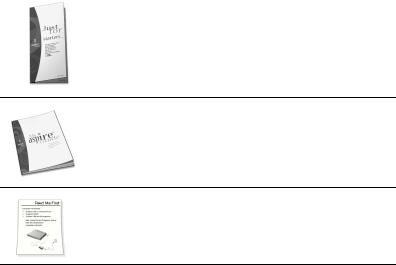
vii
First things first
We would like to thank you for making the Aspire series of notebook computers your choice for your mobile computing needs. We hope you will be happy with your Aspire as much as we enjoyed making it for you.
Your guides
To help you use your Aspire, we have designed a set of guides:
First off, the Just for Starters... poster helps you get started with setting up your computer.
This User’s guide introduces you to the many ways your computer can help you be more productive. This guide provides clear and concise information about the computer, so read it thoroughly.
Lastly, there may be a Read me first sheet included with your package which contains important reminders and updates. So, please read through it.
For more information about our products, services, and support information, please visit our web site (global.acer.com).

viii
Basic care and tips for using your computer
Turning your computer on and off
To turn on the computer, open the display cover, and press the power switch above the keyboard.
To turn the power off, do any of the following:
•Use the Windows shutdown command
Click on Start, and select the Windows Turn Off command.
•Use the power switch
If you set the power switch to “Shut down” in the Power Options control panel, you can use this button to turn off the computer. See Windows Help and Support for details.
Note: If you cannot power off the computer normally, press and hold the power switch for more than four seconds to shut down the computer. If you turn off the computer and want to turn it on again, wait at least two seconds before powering up.
Taking care of your computer
Your computer will serve you well if you take care of it.
•Do not expose the computer to direct sunlight. Do not place it near sources of heat, such as a radiator.
•Do not expose the computer to temperatures below 0°C (32°F) or above 50°C (122°F).
•Do not subject the computer to magnetic fields.
•Do not expose the computer to rain or moisture.
•Do not spill water or any liquid on the computer.
•Do not subject the computer to heavy shock and vibration.
•Do not expose the computer to dust and dirt.
•Never place objects on top of the computer to avoid damaging the computer.
•Do not slam the computer display when you close it.
•Never place the computer on uneven surfaces.
ix
Taking care of your AC adapter
Here are some ways to take care of your AC adapter:
•Do not connect the adapter to any other device.
•Do not step on the power cord or place heavy objects on top of it. Carefully route the power cord and any cables away from personal traffic.
•When unplugging the power cord, do not pull on the cord itself but pull on the plug.
•The total ampere ratings of the equipment plugged in should not exceed the ampere rating of the cord if you are using an extension cord. Also, the total current rating of all equipment plugged into a single wall outlet should not exceed the fuse rating.
Taking care of your battery pack
Here are some ways to take care of your battery pack:
•Use only batteries of the same kind as replacements. Turn the power off before removing or replacing batteries.
•Do not tamper with batteries. Keep them away from children.
•Dispose of used batteries according to local regulations. Recycle if at all possible.
Cleaning and servicing
When cleaning the computer, follow these steps:
1Power off the computer and remove the battery pack.
2Disconnect the AC adapter.
3Use a soft cloth moistened with water. Do not use liquid or aerosol cleaners.
If any of the following occurs:
•The computer has been dropped or the body has been damaged.
•Liquid has been spilled into the product.
•The computer does not operate normally.
Please refer to "Troubleshooting my computer" on page 73.
x
Getting familiar with
your computer
This computer combines high-performance, versatility, power management features and multimedia capabilities with a unique style and ergonomic design. Work with unmatched productivity and reliability with your new power computing partner.
This chapter gives an in-depth "tour" of the computer’s many features.
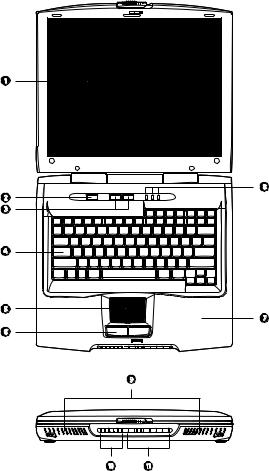
3
A tour of your computer
After setting up your computer as illustrated in the Just for Starters... poster, let us show you around your new notebook computer.
Front view

4 |
Getting familiar with your computer |
# |
Item |
Description |
|
|
|
1 |
Display screen |
Also called LCD (liquid-crystal display), displays computer |
|
|
output. |
|
|
|
2 |
Power button |
Turns on the computer power. |
3 |
Launch keys |
Buttons for launching frequently-used programs. See |
|
|
“Launch keys” on page 21 for more details. |
|
|
|
4 |
Keyboard |
Inputs data into your computer. |
|
|
|
5 |
Touchpad |
Touch-sensitive pointing device which functions like a |
|
|
computer mouse. |
|
|
|
6 |
Click buttons (left |
The left and right buttons function like the left and right |
|
and right) |
mouse buttons. |
|
|
|
7 |
Palmrest |
Comfortable support area for your hands when you use the |
|
|
computer. |
|
|
|
8 |
Lock indicators |
LEDs (light emitting diodes) that show the status of the lock |
|
|
keys. |
|
|
|
9 |
Speakers |
Outputs sound. |
|
|
|
10 |
Status indicators |
LEDs (light emitting diodes) that show the status of the |
|
|
computer and its functions and components. |
|
|
|
11 |
Audio DJ controls |
Button and indicators for the Audio DJ function. For more |
|
and indicators |
information, see “Using the Audio DJ feature” on page 27. |
|
|
|
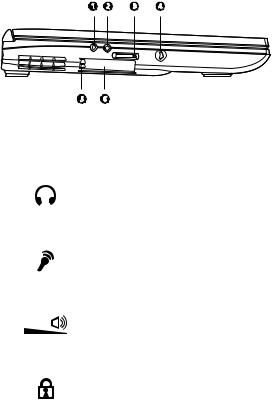
5
Left view
# |
Item |
Description |
|
|
|
1 |
Speaker/headphone-out jack |
Connects to audio line-out devices (e.g., |
|
|
speakers, headphones). |
|
|
|
2 |
Microphone-in jack |
Connects an external microphone. |
|
|
|
3 |
Volume control slider |
Adjusts the volume level. |
|
|
|
4 |
Security keylock |
Connects to a Kensington-compatible computer |
|
|
security lock. |
|
|
|
5 |
PC Card eject buttons |
Eject the selected PC Card from its slot. |
|
|
|
6 |
PC Card slots |
Accepts one Type III or two Type II/I PC Card(s). |
|
|
|
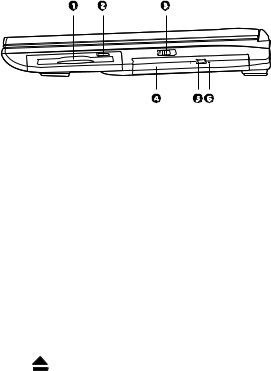
6 |
Getting familiar with your computer |
Right view
# |
Item |
Description |
|
|
|
|
|
1 |
Floppy drive |
Accepts a 3.5-inch diskette. |
|
|
|
|
|
2 |
Floppy drive eject button |
Press to eject the diskette from the floppy drive. |
|
|
|
|
|
3 |
Wireless networking button |
Enables or disables the wireless networking feature. |
|
|
|
|
|
4 |
Optical drive |
Depending on your model: |
|
|
|
• |
CD-ROM drive reads CDs |
|
|
• |
DVD-ROM drive reads CDs and DVDs |
|
|
• |
DVD/CD-RW combo drive reads CDs and |
|
|
|
DVDs, and writes to CD-Rs and CD-RWs. |
|
|
|
|
5 |
Optical drive eject button |
Ejects the disc from the optical drive. |
|
|
|
|
|
6 |
Optical drive emergency |
Ejects the disc from the optical drive when the |
|
|
eject hole |
computer is turned off. See “How do I eject the |
|
|
|
optical drive tray with the computer turned off?” on |
|
|
|
page 76 for more details. |
|
|
|
|
|
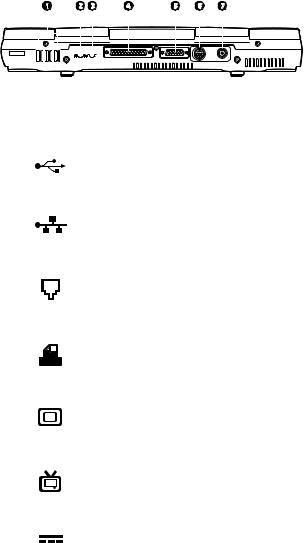
7
Rear view
|
|
|
|
|
|
|
|
|
|
|
|
|
|
|
|
|
|
|
|
|
|
|
|
|
|
|
|
|
|
|
|
|
|
|
|
|
|
|
|
|
|
|
|
|
|
|
|
|
|
|
|
|
|
|
|
|
|
|
|
|
|
|
|
|
|
|
|
|
|
|
|
|
|
|
|
|
|
|
|
|
|
|
|
|
|
|
|
|
|
|
|
|
|
|
|
|
|
|
# |
Item |
|
|
Description |
||||||||||||||||||||||||||||
|
|
|
|
|
|
|
|
|
|
|
|
|
|
|
|
|
|
|
|
|
|
|
|
|
|
|
|
|
|
|
|
|
1 |
USB ports |
|
|
Connects to USB devices (e.g., USB digital camera). |
||||||||||||||||||||||||||||
|
|
|
|
|
|
|
|
|
|
|
|
|
|
|
|
|
|
|
|
|
|
|
|
|
|
|
|
|
|
|
|
|
2 |
Network jack |
|
|
Connects to an Ethernet 10/100-based network. |
||||||||||||||||||||||||||||
|
|
|
|
|
|
|
|
|
|
|
|
|
|
|
|
|
|
|
|
|
|
|
|
|
|
|
|
|
|
|
|
|
3 |
Modem jack |
|
|
Conncts a phone line (only for models with an internal |
||||||||||||||||||||||||||||
|
|
|
|
|
|
|
|
|
|
|
|
|
|
|
|
|
|
|
|
|
|
|
|
fax/data modem). |
||||||||
|
|
|
|
|
|
|
|
|
|
|
|
|
|
|
|
|
|
|
|
|
|
|
|
|
|
|
|
|
|
|
|
|
4 |
Parallel port |
|
|
Connects to a parallel device (e.g., parallel printer). |
||||||||||||||||||||||||||||
|
|
|
|
|
|
|
|
|
|
|
|
|
|
|
|
|
|
|
|
|
|
|
|
|
|
|
|
|
|
|
|
|
5 |
External display port |
|
|
Connects to a display monitor. |
||||||||||||||||||||||||||||
|
|
|
|
|
|
|
|
|
|
|
|
|
|
|
|
|
|
|
|
|
|
|
|
|
|
|
|
|
|
|
|
|
6 |
Video-out port |
|
|
Connects to a display device with S-video input. |
||||||||||||||||||||||||||||
|
|
|
|
|
|
|
|
|
|
|
|
|
|
|
|
|
|
|
|
|
|
|
|
|
|
|
|
|
|
|
|
|
7 |
DC-in jack |
|
|
Connects to the AC adapter. |
||||||||||||||||||||||||||||
|
|
|
|
|
|
|
|
|
|
|
|
|
|
|
|
|
|
|
|
|
|
|
|
|
|
|
|
|
|
|
|
|
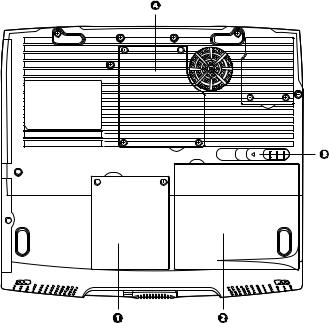
8 |
Getting familiar with your computer |
Bottom view
# |
Item |
Description |
|
|
|
1 |
Hard disk bay |
Houses the computer’s hard disk. |
|
|
|
2 |
Battery bay |
Houses the computer’s battery pack. |
|
|
|
3 |
Battery release latch |
Slide and hold to unlatch the battery pack. |
|
|
|
4 |
Memory compartment |
Houses the computer’s memory upgrade slot. |
|
|
|
9
Features
This computer was designed with the user in mind. Here are just a few of its many features:
Performance
•Intel® Pentium® 4 processor with on-die level 2 cache
•256 MB memory expandable to 1 GB
•High-capacity, Enhanced-IDE hard disk
•Lithium-Ion battery pack
•Power management system
Multimedia
•16-bit high-fidelity stereo audio with 3-D sound
•Built-in dual stereo speakers
•Internal optical drive (CD-ROM, DVD-ROM, or DVD/CD-RW combo)
•Audio DJ feature
•Large LCD display with simultaneous LCD and CRT display support
•S-video (NTSC/PAL) output
Connectivity
•High-speed 56Kbps V.90 fax/data software modem
•Ethernet/Fast Ethernet (10/100 Mbps)
•Universal Serial Bus (USB) ports
•Wireless networking (802.11b) option
Human-centric design and ergonomics
•All-in-one design (CD or DVD, floppy drive, and hard disk)
•Sleek, smooth and stylish design
•Full-sized keyboard
•Wide and curved palm rest
•Ergonomically-centered touchpad pointing device
•Launch keys
•Audio DJ feature
10 |
Getting familiar with your computer |
Expansion
•CardBus PC Card slots
•Upgradeable memory and hard disk
11
Display
The large graphics display offers excellent viewing, display quality and desktopperformance graphics. The computer supports a Thin-Film Transistor (TFT) liquid crystal display (LCD) displaying up to 16.7 million colors at 1024x768 eXtended Graphics Array (XGA) resolution.
Video performance
Video peformance is boosted with 16 MB of Double Data Rate (DDR) Synchronous Dynamic Random Access Memory (SDRAM) for graphics-intensive games and applications.
Simultaneous display
The computer’s large display and multimedia capabilities are great for giving presentations. If you prefer, you can also connect an external monitor when giving presentations. This computer supports simultaneous LCD and CRT display. Simultaneous display allows you to control the presentation from your computer and at the same time face your audience. You can also connect other output display devices such as an LCD projector or a television for large-audience presentations.
Dualview
The computer’s video chip takes advantage of the multi-display capability of Windows. This feature allows you to extend your desktop to an external display device, such as an external monitor or projector. With this feature enabled, you can move program windows to and from the computer LCD and external display device. For more information, see Windows help.
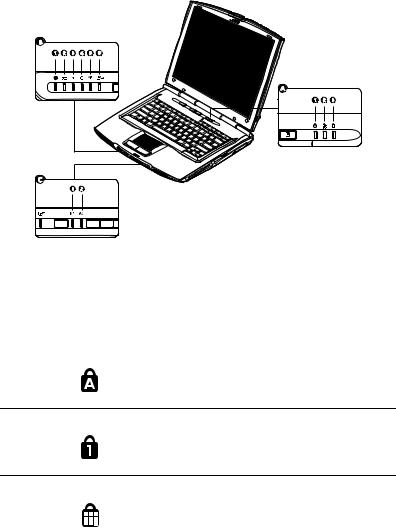
12 |
Getting familiar with your computer |
Indicators
The computer has easy-to-read lock indicators (A) found above the keyboard, and status indicators (B) and Audio DJ mode indicators (C) on the front panel of the computer.
These indicators show the status of the computer and its components.
# |
Function |
Description |
|
|
|
A. Lock indicators |
|
|
|
|
|
1 |
Caps lock |
Caps Lock is activated. |
2 |
Num lock |
Numeric Lock (for embedded keypad) is activated. |
3 |
Scroll lock |
Scroll Lock is activated. |
|
|
|
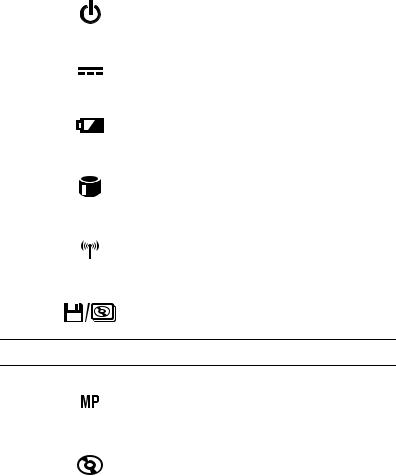
13
# |
Function |
Description |
|
|
|
B. Status indicators |
|
|
|
|
|
4 |
Power |
Lights when the computer is on. |
|
|
|
5 |
AC power |
Computer is running on AC power. |
|
|
|
6 |
Battery charge |
Battery is being charged. |
|
|
|
7 |
Hard disk activity |
Hard disk is being accessed. |
|
|
|
8 |
Wireless networking |
Wireless networking feature is enabled. Use the wireless |
|
|
networking switch to enable or disable this feature. See |
|
|
“Right view” on page 6 for the location of this switch. |
|
|
|
9 |
Optical drive activity |
Optical drive (CD or DVD) is being accessed. |
C. Audio DJ mode indicators
10 |
MP |
Audio DJ is set to launch the Windows Media Player for |
|
|
audio playback. |
|
|
|
11 |
CD |
Audio DJ is set to CD playback. |
|
|
|
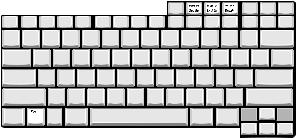
14 |
Getting familiar with your computer |
Keyboard
The keyboard has full-sized keys with an embedded keypad, separate cursor keys, two Windows keys and twelve function keys.
Special keys
Lock keys
The keyboard has four lock keys which you can toggle on and off.
Lock Key |
Description |
|
|
Caps Lock |
When Caps Lock is on, all alphabetic characters typed are in uppercase. |
|
|
Num Lock |
When Num Lock is on, the embedded keypad is in numeric mode. The keys |
|
function as a calculator (complete with the arithmetic operators +, -, *, and |
|
/). Use this mode when you need to do a lot of numeric data entry. A |
|
better solution would be to connect an external keypad. See “External |
|
keyboard” on page 43. |
|
|
Scroll Lock |
When Scroll Lock is on, the screen moves one line up or down when you |
(Fn-Scroll Lk) |
press ↑ or ↓ respectively. Scroll Lock does not work with some applications. |
|
|
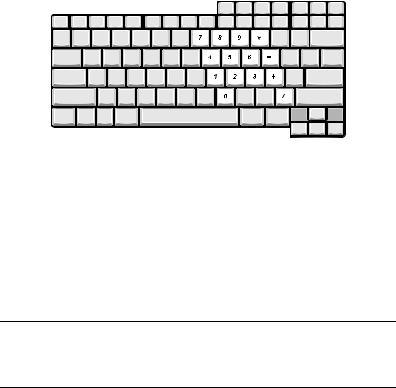
15
Embedded keypad
The embedded keypad functions like a desktop numeric keypad. It is indicated by small characters located on the lower edge of the keycaps. The embedded keypad can function in numeric mode or cursor-control mode.
Desired Access |
Num lock On |
Num lock Off |
|
|
|
Number keys on embedded |
Type numbers in a normal |
Hold Shift while typing |
keypad |
manner. |
numbers. |
|
|
|
Cursor-control keys on |
Hold Shift while using |
Use cursor-control keys in a |
embedded keypad |
cursor-control keys. |
normal manner. |
Main keyboard keys |
Hold Fn while typing letters |
|
on embedded keypad. Also |
|
hold down Shift for capital |
|
letters. |
Hold Fn while typing letters on embedded keypad. Also hold down Shift for capital letters.
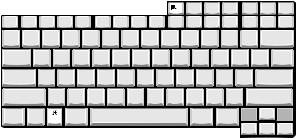
16 |
Getting familiar with your computer |
Windows keys
The keyboard has two keys that perform Windows-specific functions.
Key |
Description |
|
|
Windows logo key |
Start button. Combinations with this key perform special functions. |
|
Below are a few examples: |
|
+ Tab (Activates next Taskbar button) |
|
+ E (Explores My Computer) |
|
+ F (Finds Document) |
|
+ M (Minimizes All) |
|
Shift + + M (Undoes Minimize All) |
|
+ R (Displays Run dialog box) |
|
|
Application key |
Opens the application’s context menu (same as right-click). |
|
|

17
Hotkeys
The computer uses hotkeys or key combinations to perform functions such as controlling the screen brightness and specifying where to display output.
HotKey |
Function |
Description |
|
|
|
Fn-Esc |
Speaker toggle |
Turns the speakers on and off. |
|
|
|
Fn-F3 |
Standby |
Puts the computer in standby mode. |
|
|
|
Fn-F4 |
Hibernation |
Puts the computer in hibernation mode. |
|
|
|
Fn-F5 |
Display toggle |
Switches display output between the display |
|
|
screen, external monitor (if connected) and |
|
|
both the display screen and external monitor. |
|
|
|
Fn-F6 |
Brightness up |
Increases the screen brightness. |
|
|
|
Fn-F7 |
Brightness down |
Decreases the screen brightness. |
|
|
|
Fn-F8 |
Wireless networking toggle |
Toggles wireless networking on and off. |
When activating hotkeys, press and hold the Fn key before pressing the other key in the hotkey combination.

18 |
Getting familiar with your computer |
Keyboard ergonomics
Located below the keyboard, the wide and curved palm rest is ergonomically designed to provide you with a very comfortable place to rest your hands while you type.
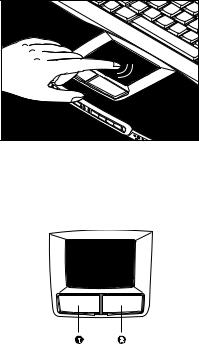
19
Touchpad
The built-in touchpad is a PS/2-compatible pointing device that senses movement on its surface. This means the cursor responds as you move your finger on the surface of the touchpad. The central location on the palm rest provides optimum comfort and support.
Touchpad basics
The following teaches you how to use the touchpad:
•Move your finger across the touchpad to move the cursor.
•Press the left (1) and right (2) buttons located on the edge of the touchpad to do selection and execution functions. These two buttons are similar to the left and right buttons on a mouse. Tapping on the touchpad produces similar results.
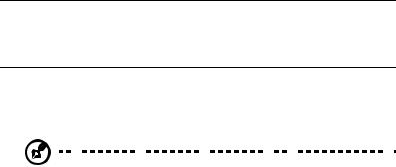
20 |
Getting familiar with your computer |
Function |
Left Button |
Right |
Tap |
||
|
|
Button |
|
|
|
Execute |
Click twice quickly. |
Tap twice (at the same speed as |
|
|
double-clicking the mouse button). |
|
|
|
Select |
Click once. |
Tap once. |
Drag |
Click and hold, |
|
then use finger to |
|
drag the cursor on |
|
the touchpad. |
Tap twice (at the same speed as double-clicking the mouse button) and hold finger to the touchpad on the second tap to drag the cursor.
Access |
|
|
|
Click once. |
|
|
|
|
|
|
||
context |
|
|
|
|
|
|
|
|
|
|
|
|
menu |
|
|
|
|
|
|
|
|
|
|
|
|
|
|
|
|
|
|
|
|
|
|
|
|
|
|
|
|
|
|
|
|
|
|
|
|
|
|
Note: Keep your fingers dry and clean when using the touchpad. Also keep the touchpad dry and clean. The touchpad is sensitive to finger movements. Hence, the lighter the touch, the better the response. Tapping too hard will not increase the touchpad’s responsiveness.
